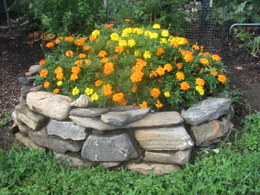Marigold Growing Guide
French marigold (Tagetes patula) is an annual flower native to Central America and it is a part of the very large Asteraceae family.
They are very easy to grow and are found in large numbers in garden centers. The attractive flowers bloom all summer long right up to the first frost. They reach an average height of 10 to 12-inches and spread up to 12-inches. Bloom colors range from yellow, orange, red and bi-color.
Not seen as often is the African marigold (Tagetes erecta) which reaches an average height of 12 to 24-inches tall and is also native to Central America. There are also dwarf varieties available.
In addition to being deer resistant, marigolds attract butterflies and hummingbirds. The flowers do not have an attractive fragrance, which makes it a natural insect repellent. This makes them very useful as companion plants in the vegetable garden.
Starting from Seed
Marigolds can be started indoors 6 to 8-weeks before your last expected frost date. Most gardeners want immediate color in their flower garden and prefer to purchase flowering plants in six packs from garden centers.
Follow the instructions on the seed packet. Sow the seeds evenly and thinly in a sterile seed starting mix in cell packs or pots.
You can direct sow them in your flower garden right after your last frost date. A large mass planting makes an impressive floral display.
For more detailed information visit the seed starting page.
Soil Preparation
Plant in full sun in a nice loose well-drained garden soil. As soon as the soil is frost-free and can be worked, till the soil by digging down 8 to 12-inches turning the soil over with a garden fork.
Remove any large rocks and stones. The small stones remaining will do no harm and actually benefit the soil by adding some micro-nutrients to the soil. They will do best in a slightly acid soil with a pH range of 6.2 to 6.8.
Planting Marigolds
They should be planted in the late spring after the last expected frost.
Plant them 8 to 12-inches apart or in groups of 3 or 5 in front of taller plants. Dig a hole as deep as the pot and twice as wide. To the soil you just removed add the same amount of good garden soil so you have a nice blend of new and native soil.
Take the plant out of the pot and gently loosen the root ball pulling away any roots that have grown in a circle around the pot.
Place the root ball in the hole with the growing crown even with or an inch higher than the surrounding soil. Gently spread out the roots and back fill the hole around the root ball leaving a shallow depression around your plant. Fill the depression with water to settle the soil around the roots adding more soil if necessary and water again. Water daily tapering off as the roots grow and get established.
Watering and Care
They are low maintenance and easy to care for. All you need to do is add a layer of mulch to help retain moisture and keep out competing weeds. Your plants should get an inch of water each week and during dry spells give some water to keep the soil moist. They usually do not need any fertilizer, but a light side dressing of organic fertilizer can be placed around the plant in the spring.
To increase blooms deadhead any spent flowers as they occur.
Diseases and Pests
Marigolds have no serious insect or disease problems.
Popular Marigold Varieties
French marigold (Tagetes patula)
Alumia Vanilla Cream, Bambino, Bonanza Bee, Bonanza Flame, Endurance Orange, Endurance Yellow, Fireball, Golden Guardian, Janie Deep Orange, Janie Flame, Janie Primrose Yellow, Janie Yellow, Sparky, Strawberry Blonde, Tiger Eyes
African marigold (Tagetes erecta)
Crackerjack, Garland Orange, Hawaii, Mandarin, Mary Ellen, Mission Giant Yellow, Moonlight, Moonsong Deep Orange, Moonstruck Yellow, Primrose Lady Hybrid, Smiles, Snowball Hybrid, Sugar & Spice, Sunset Giant, Vanilla Improved
Sources: Burpee, Park Seed, Seeds Now.
Garden thoughts:
“Mistress Mary, quite contrary,
How does your garden grow?
With Silver Bells, and Cockle Shells,
And marigolds all in a row.”
― Frances Hodgson Burnett, The Secret Garden
Garden Spikes newsletters give you timely information once or twice a month. Subscribe Free to the Garden Times newsletter below.
Your email address will only be used to send you a newsletter and will never be sold. You can unsubscribe at any time.

